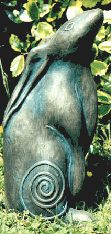
Note George Ewart Evans and David Thomson in The Leaping Hare . . .
One unusual feature of the hare’s behavior has caused a great deal of interest . . . both among naturalists and the general public. This is the hare’s frequent choosing of aerodromes on which to converge and, in fact, to live.
. . . Hares are to be seen on many airfields in many different countries: Prague, Frankfurt, Heathrow and so on. . . . This is the kind of behavior, contradictory and unpredictable as it is, that is nevertheless not too much out of character in the hare. For the common phrase hare-brained refers not so much to a lack of intelligence as to a wild impetuosity. Why, for instance, does such a shy and fearful creature choose the noisiest, most dangerous and most frequented spot in the modern urban complex to disport itself in?
There have been many attempts to explain why the hare appears to be so attracted to airfields. [Henry] Tegner [in his book on the hare] quotes a Natural History Museum expert as saying: “The hares seem to like the noise and the vibration.
. . . Others have put forward the theory that it is the abundant food they can get on the stretches of well-kept turf between the runways that has drawn hares to aerodromes. Good grazing is undoubtedly a factor in keeping them on an airfield; but it is questionable whether it is the main attraction. There is strong evidence that aircraft themselves attract the hares in the first place. For when in recent years an aerodrome frequented by hares was closed for repairs, the hares followed the aeroplanes to the satellite aerodrome which became the temporary landing place. But why should aeroplanes attract hares?
. . . Early reports of the hare following aircraft suggest that the hare’s reaction is inbuilt, an instinctive impulse to emulate the speed of the aeroplane by running alongside it: it suggests that the hare is purposefully ‘taking on’ the aircraft, responding to what it interprets as a challenge. This fits in well with what we know of the playfulness of the hare, of its delight in its own swiftness, and its readiness – in spite of its fear – to pit itself on occasion against a fast moving object. The hare’s main strength lies in its speed: it does not go to ground and relies on its speed to get itself out of trouble; therefore when it plays, as it appears to be doing when it courses alongside aircraft, it is likely that in showing its speed it is using one of its strongest instincts of self-expression.
Related Off-site Link:
Milan Airport Shut by Hare Plague – Mark Duff (BBC News, June 17, 2007).






















